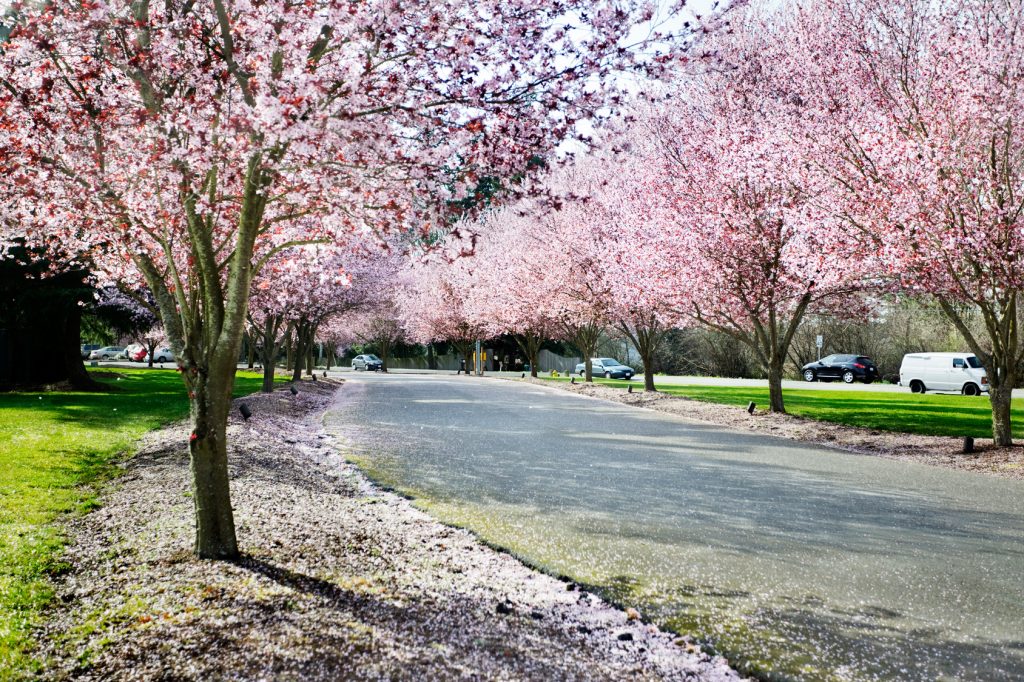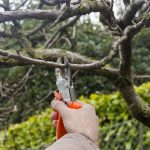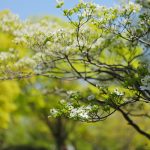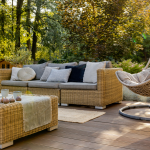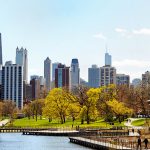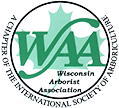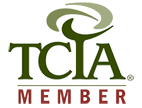The spring season has arrived in Chicago and even though the summer is right around the corner, there is still time to take in the sight of the flowering trees that can be found all throughout Chicagoland. The warmer weather brought the fresh spring colors of blooming trees, shrubs, and flowers which always inject much needed color into the landscape after the dull colors of winter. The spring air and fresh flowers are always a nice reminder of why spring is such a great time of year in the Midwest.
There are many types of flowering trees and shrubs in the Chicago area that you can appreciate and even incorporate into your own yard or landscape. The following is a guide to the flowering trees and shrubs of the Chicago area to look out for this spring. If you already have beautiful flowering trees or shrubs on your property and want to ensure that they get the proper care and maintenance, talk to our professionals at Hendricksen Tree Care about our tree care services.
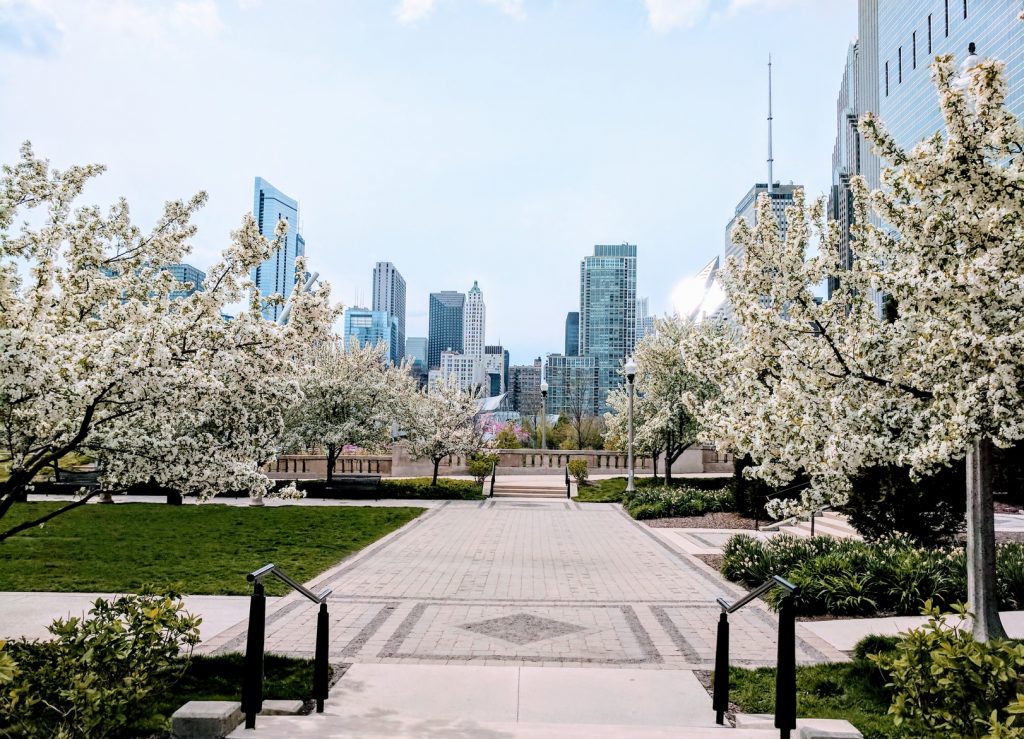
What types of flowering trees will you see this Spring in Chicago?
People in the Midwest are always excited when spring arrives because it means the end of the long, dull, and freezing winter. The warmer weather has already arrived, and the fresh spring colors of blooming trees, shrubs, and flowers will not be far behind. Residents of Chicago and its suburbs will soon be enjoying the beautiful colors of spring, a reminder that the summer is quickly approaching.
In the coming weeks, you should start to notice the blooms of flowering trees and shrubs which will inject some color into the landscape. The fresh spring blooms are always a nice contrast to the dull colors of winter, which is one of the reasons why the spring is such a great time of year in the Midwest. There are many types of flowering trees and shrubs in the Chicago area that you can appreciate and even incorporate into your own yard or landscape.
The following is a guide to the flowering trees and shrubs of the Chicago area to look out for this spring. If you already have beautiful flowering trees or shrubs on your property and want to ensure that they get the proper care and maintenance, talk to our professionals at Hendricksen Tree Care about our tree care services.
White Ash
White ash trees (Fraxinus alba) flower early in the spring, before they even grow back their leaves. Male white ash trees bloom each year while females will bloom once every 2-3 years, but they bloom heavily when they do. The flowers of male and female ash trees can be yellowish green to greenish purple and they are about an eighth of an inch in diameter. The pollination of ash tree flowers is mainly done by wind pollination.
Sassafras
Sassafras (Sassafras albidum) is a tree native to the Chicago area that flowers just before its leaves emerge. Each sassafras tree will only grow either male or female flowers. These flowers grow in clustered groups at the ends of the twigs and are greenish yellow or yellow in color. Sassafras flowers are typically pollinated by bees.
Willow Trees
Willow trees (Salix sp.) don’t flower until mid-spring when they start to develop their leaves. Examining the structure of the willow’s flower as well as the presence of seeds helps determine the sex of the tree. The flowers on male and female willows are called catkins. These flowers are generally 1-3 inches long with a narrow, cylindrical shape, and they are green in color. They are mostly pollinated by bees, but they can also by pollinated by the wind.
Ohio Buckeye
Male and female flowers of the Ohio buckeye (Aesculus glabra) grow separately but will bloom on the same tree. These flowers grow in clusters that can get up to one foot in length and they are generally yellow-green in color. The Ohio buckeye flowers in April and May and the flowers are pollinated by bees and hummingbirds.
American Sweetgum
The American sweetgum (Liquidambar styraciflua) is a native tree to Illinois that can grow to be 75 feet tall. It gets its name from its sap which is sweet and gummy. Like the Ohio buckeye, sweetgum trees also produce male and female flowers on the same plant. They differ in appearance however as the male flowers grow in clusters, can be 1-2½ inches long, and are greenish yellow. Female sweetgum flowers have a globe-like shape and are green in color.
Black Locust
Black locust trees (Robinia pseudoacacia) develop fragrant flower clusters late in the spring after they have grown back their leaves. The flowers of a black locust are small and white with a yellow spot in the middle, and they grow in 4-6-inch-long drooping clusters. Black locust flowers are pollinated by bumblebees, butterflies, honeybees, and hummingbirds.
Eastern Redbud
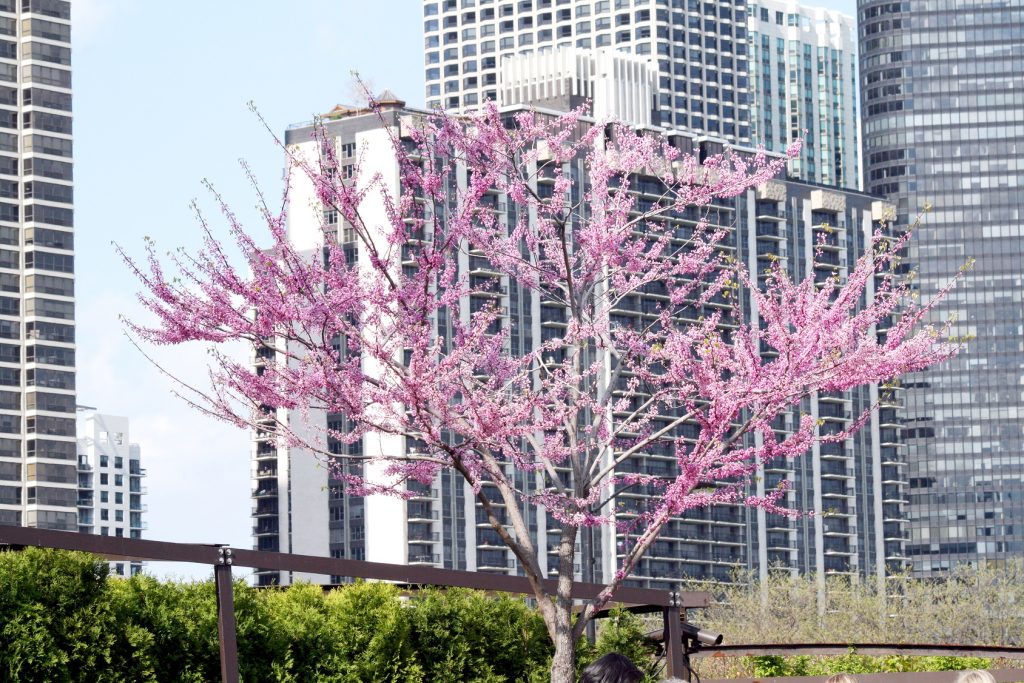
Eastern Redbud tree in bloom in Chicago
The eastern redbud (Cercis canadensis) is a tree native to the Midwest that can grow up to 25 feet tall. These trees generally have a short trunk, so their branches start closer to the ground. The flowers of an eastern redbud are purplish pink in color and start growing early in the spring on the trunk and branches before the leaves emerge. Eastern redbuds are typically pollinated by various species of bees.
Yellow Poplar
Yellow poplars, or tulip poplars (Lirodendron tulipifera), have the largest flower of any tree native to Illinois. These flowers are cup-shaped with a cone-shaped cluster of pistils surrounded by six yellow-green petals and they appear in April and May. They can grow to be 2 inches in length and they have ample nectar which attracts bees and other insect pollinators.
Dogwoods
Dogwood trees (Cornus sp.) produce flowers from March until June. There are many species of dogwood trees in the Chicago area including the Cornelian cherry dogwood (Cornus mas) that produces both fruits and flowers in late March or April. The flowers of the Cornelian cherry dogwood are star-shaped, and they grow in clusters when the temperature is still cool. The nectar in these flowers attracts bees, butterflies, and other species.
Crabapple
There are a wide variety of crabapple trees (Malus spp. and cvs.) that range in height, canopy shape, and flower type in the Chicago area. The flowers of a crabapple tree tend to grow in clusters and they range in color from purple and pink to white. These trees flower heavily which is why they are loved by gardeners and homeowners looking to improve their landscape. Crabapple species do particularly well in urban environments because they are resistant to many diseases.
Carolina Silverbell
The Carolina silverbell (Halesia tetraptera) is a tree or shrub that produces white, bell-shaped flowers in April and May that dangle from the branches. These plants flower around the same time their leaves emerge, and they eventually transform into nutlike fruits by the end of the season. Some Carolina silverbells develop as shrubs while others can grow to be 40-foot-tall trees. The unique beauty of the hanging flowers is why the Carolina silverbell was chosen as one of Illinois’ Best Plants.
Basswood Trees
Basswood trees (Tilia sp.) are most easily recognized by their large, heart-shaped leaves and their drooping flower clusters. The cream-colored flowers of basswood trees bloom in June and appear in drooping clusters of 5 to 10 individual flowers. Basswood flowers are hermaphroditic, with both male and female parts, and they are very fragrant. The fragrance and appearance of these flowers make basswood trees desirable for their ornamental qualities. Their flowers also attract bees which are responsible for their pollination.
Magnolia Trees
Magnolia trees (Magnolia sp.) are deciduous trees with large, fragrant flowers. There are multiple species of magnolia trees that can be found in Illinois but the only species that is truly native to Illinois is the cucumber tree (Magnolia acuminata). The flowers on most magnolia species are star shaped or bowl shaped and while they are mostly white in color, they can also be pink, green, yellow, or purple. Depending on the species, magnolia trees can be anywhere from 25 to 70 feet in height, and they are typically planted as an ornamental tree because of their large flowers.
Apple Serviceberry
Apple serviceberry trees (Amelanchier x grandiflora) are a hybrid between two serviceberry trees native to Illinois: Downy serviceberry (Amelanchier arborea) and the Allegheny serviceberry (Amelanchier laevis). These trees show beauty in all seasons with fragrant white flowers in the spring, dark blue edible berries and blue-green leaves in the summer, and vibrant orange and red leaves in the fall. Apple serviceberry trees grow between 15 and 25 feet tall and they are often planted to accentuate a garden.
Red Buckeye Tree
The red buckeye tree (Aesculus pavia) is known for its striking, tubular red flowers that bloom in upright clusters in early to mid-spring. These vibrant blossoms, typically 4–8 inches long, are highly attractive to hummingbirds and pollinators. The flowers appear before the tree fully leafs out, making their brilliant color stand out even more. Red buckeyes are small, ornamental trees or large shrubs, often used for their dramatic spring display and ability to thrive in part-shade environments.
White Fringetree
White fringetrees (Chionanthus virginicus) are admired for their delicate, fragrant, and airy white flowers that bloom in late spring. The blossoms appear as cascading clusters of fringe-like petals, giving the tree a soft, cloud-like appearance. These showy flowers are especially eye-catching against the tree’s dark green foliage and attract a variety of pollinators. White fringetrees are often used as ornamental accents in landscapes due to their graceful flowering and adaptability to various soil conditions.
Black Cherry
Black cherry trees (Prunus serotina) produce abundant clusters of small, fragrant white flowers in late spring. These blossoms are arranged in elongated, drooping racemes that create a striking contrast against the emerging green foliage. The flowers are highly attractive to pollinators such as bees and butterflies, playing a vital role in local ecosystems. While not as showy as some ornamental trees, the subtle elegance of black cherry blooms add seasonal interest to naturalized and woodland landscapes.
American Plum
American plum trees (Prunus americana) burst into bloom in early to mid-spring, producing clusters of fragrant, white flowers before the leaves fully emerge. These blossoms cover the branches, creating a striking and delicate display. The flowers typically appear in small groups and have five petals each, adding a soft, ornamental charm to the landscape. Their early blooming makes them a valuable source of nectar in the spring and a picturesque addition to native gardens and naturalized areas.
Hawthorne
Hawthorn trees (Crataegus spp.) are known for their dense clusters of white or pink, five-petaled flowers that bloom in late spring. These blossoms often cover the entire canopy, creating a showy and fragrant display that attracts bees, butterflies, and other pollinators. The flowers typically appear before the tree’s dense foliage fully matures, enhancing their visibility and ornamental appeal. Though beautiful, hawthorn flowers can have a slightly musky scent that varies by species. Their striking blooms are often followed by bright red berries in the fall, adding year-round interest.
Tree Care for your Flowering Trees and Shrubs
If the trees and shrubs on your property have not flowered yet, you can expect many of them to flower in the next 4-6 weeks, weather permitting of course. The spring flowers on many of these Illinois trees are truly a sight to behold and having a flowering tree on your property can really enhance the natural beauty of your landscape each spring. People who are doing new tree planting this year should consider planting a tree or shrub that flowers every spring.
The tree species mentioned in this guide are native to the Chicago area and can survive quite well in our climate. However, all types of Chicagoland trees and shrubs are vulnerable to pests, diseases, and damage from various sources that can shorten their lives. At Hendricksen Tree Care, we provide complete tree care services to protect your trees from insects and diseases and nurse them back to health when there is a problem. Our certified arborists are dedicated to keeping your trees vibrant and healthy so that they grace your property with the same flowering beauty every spring.
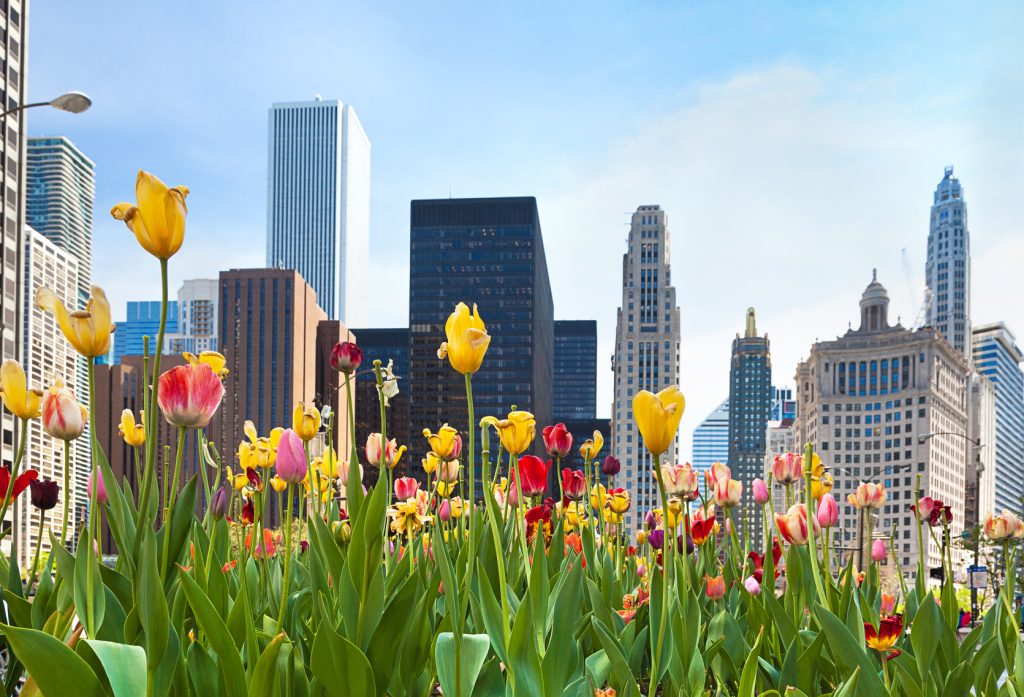
Spring flowers blooming in Chicago, IL
Contact Hendricksen Tree Care at (847) 348-8302 for more information about our tree care services in the north and northwest Chicago suburbs.
